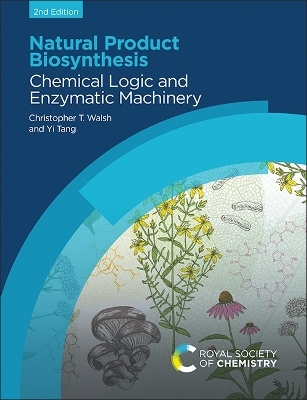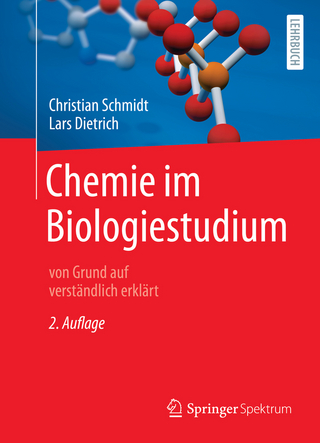
Natural Product Biosynthesis
Chemical Logic and Enzymatic Machinery
Seiten
2022
|
2nd edition
Royal Society of Chemistry (Verlag)
978-1-83916-564-1 (ISBN)
Royal Society of Chemistry (Verlag)
978-1-83916-564-1 (ISBN)
This second edition integrates many new findings into the underlying enzymatic mechanisms and the catalytic machinery for building the varied and complex end product metabolites. This text will serve as a reference point for chemists of every subdiscipline, including synthetic organic chemists and medicinal chemists.
Authored by leading experts in the enzymology of natural product biosynthesis, this completely revised and updated edition provides a description of the types of natural products, the biosynthetic pathways that enable the production of these molecules, and an update on the discovery of novel products in the post-genomic era. Although some 500 000 – 600 000 natural products have been isolated and characterized over the past two centuries, there may be a 10-fold greater inventory awaiting immediate exploration based on biosynthetic gene cluster predictions. The approach of this book is to codify the chemical logic that underlies each natural product structural class as they are assembled from building blocks of primary metabolism.
This second edition integrates many new findings into the sets of principles of the first edition that parsed categories of natural product chemistries into the underlying enzymatic mechanisms and the catalytic machinery for building the varied and complex end product metabolites. New chapters include evaluation of a core set of thermodynamically activated but kinetically stable metabolites that power both primary and secondary metabolic pathways. Also, after decades of uncertainty about the existence of various pericyclase classes, a series of genome mining, heterologous expression, and enzymatic activity characterization have validated a plethora of pericyclases over the past decade. The several types of pericyclases are involved in biosynthetic complexity generation of almost every major category of natural products.
This text will serve as a reference point for chemists of every subdiscipline, including synthetic organic chemists and medicinal chemists. It will also be valuable to bioinformatic and computational biologists, pharmacognocists and chemical ecologists, and bioengineers and synthetic biologists.
Authored by leading experts in the enzymology of natural product biosynthesis, this completely revised and updated edition provides a description of the types of natural products, the biosynthetic pathways that enable the production of these molecules, and an update on the discovery of novel products in the post-genomic era. Although some 500 000 – 600 000 natural products have been isolated and characterized over the past two centuries, there may be a 10-fold greater inventory awaiting immediate exploration based on biosynthetic gene cluster predictions. The approach of this book is to codify the chemical logic that underlies each natural product structural class as they are assembled from building blocks of primary metabolism.
This second edition integrates many new findings into the sets of principles of the first edition that parsed categories of natural product chemistries into the underlying enzymatic mechanisms and the catalytic machinery for building the varied and complex end product metabolites. New chapters include evaluation of a core set of thermodynamically activated but kinetically stable metabolites that power both primary and secondary metabolic pathways. Also, after decades of uncertainty about the existence of various pericyclase classes, a series of genome mining, heterologous expression, and enzymatic activity characterization have validated a plethora of pericyclases over the past decade. The several types of pericyclases are involved in biosynthetic complexity generation of almost every major category of natural products.
This text will serve as a reference point for chemists of every subdiscipline, including synthetic organic chemists and medicinal chemists. It will also be valuable to bioinformatic and computational biologists, pharmacognocists and chemical ecologists, and bioengineers and synthetic biologists.
Major Classes of Natural Product Scaffolds and Enzymatic Biosynthetic Machinery;
The Chemical Logic for Major Reaction Types;
Polyketide Natural Products;
Peptide Natural Products I: RiPPs;
Peptide Natural Products II: Nonribosomal Peptides;
Isoprenoids/Terpenes;
Alkaloids I;
Purine- and Pyrimidine-derived Natural Products;
Phenylpropanoid Natural Product Biosynthesis;
Alkaloids II: Indole Terpenes;
Natural Product Oligosaccharides and Glycosides;
Oxygenases, Thwarted Oxygenases, and Oxygen-dependent Halogenases;
S-Adenosylmethionine;
Pericyclases in Natural Product Biosynthesis;
Natural Products Isolation and Characterization: Gene-independent Approaches;
Natural Products in the Post Genomic Era
| Erscheinungsdatum | 16.12.2022 |
|---|---|
| Verlagsort | Cambridge |
| Sprache | englisch |
| Maße | 189 x 246 mm |
| Gewicht | 1763 g |
| Themenwelt | Naturwissenschaften ► Biologie ► Biochemie |
| Naturwissenschaften ► Biologie ► Genetik / Molekularbiologie | |
| Naturwissenschaften ► Chemie ► Organische Chemie | |
| ISBN-10 | 1-83916-564-2 / 1839165642 |
| ISBN-13 | 978-1-83916-564-1 / 9781839165641 |
| Zustand | Neuware |
| Haben Sie eine Frage zum Produkt? |
Mehr entdecken
aus dem Bereich
aus dem Bereich
die Biochemie und industrielle Nutzung von Naturstoffen
Buch | Softcover (2024)
Springer Fachmedien (Verlag)
49,99 €
von Grund auf verständlich erklärt
Buch | Softcover (2022)
Springer Spektrum (Verlag)
34,99 €


